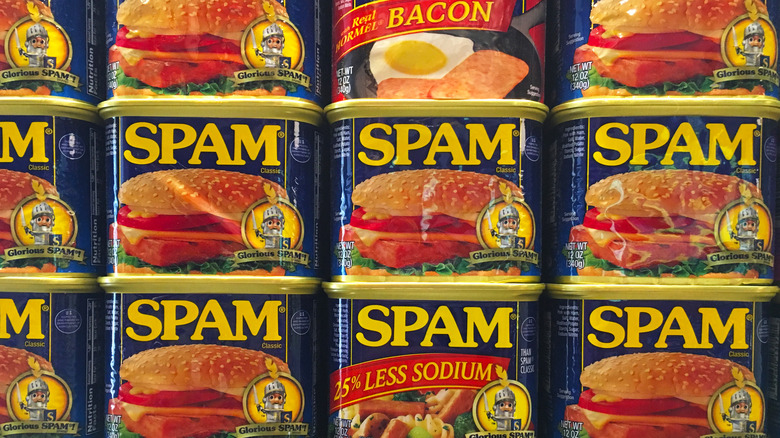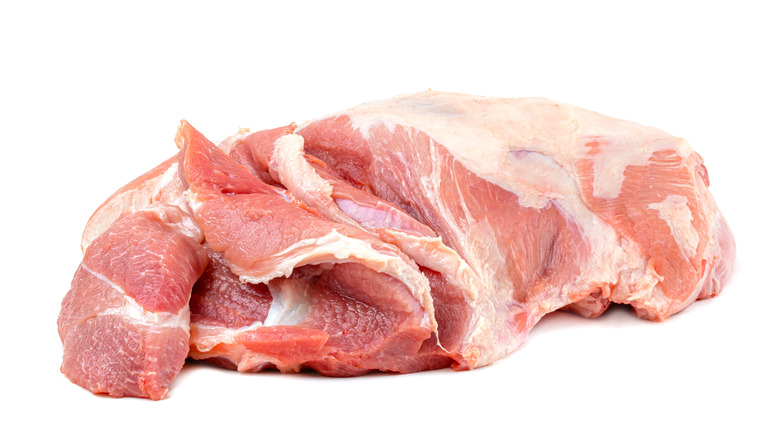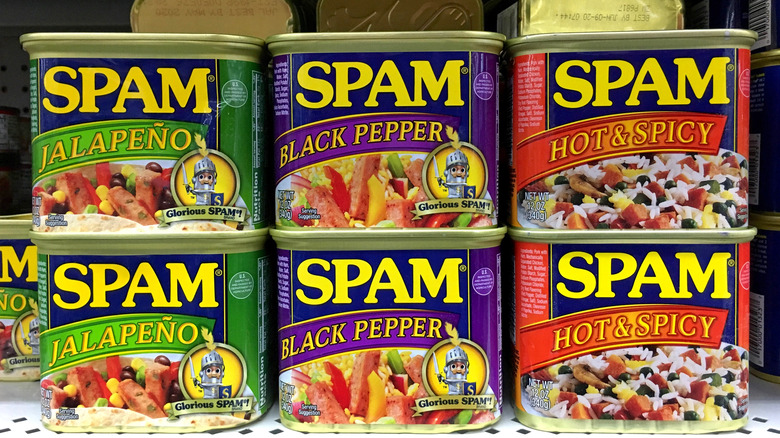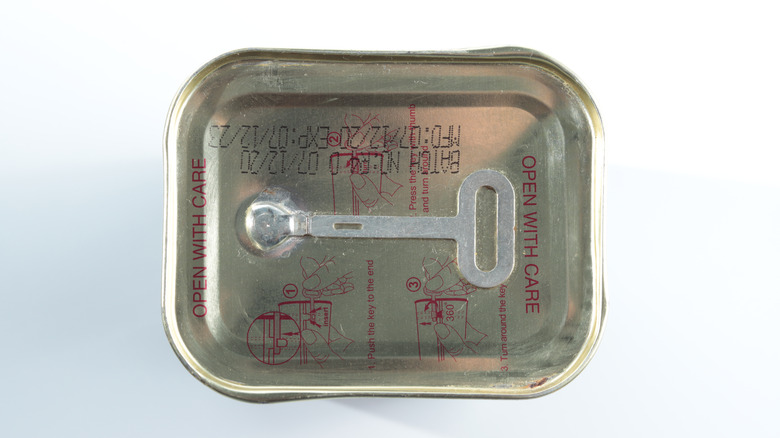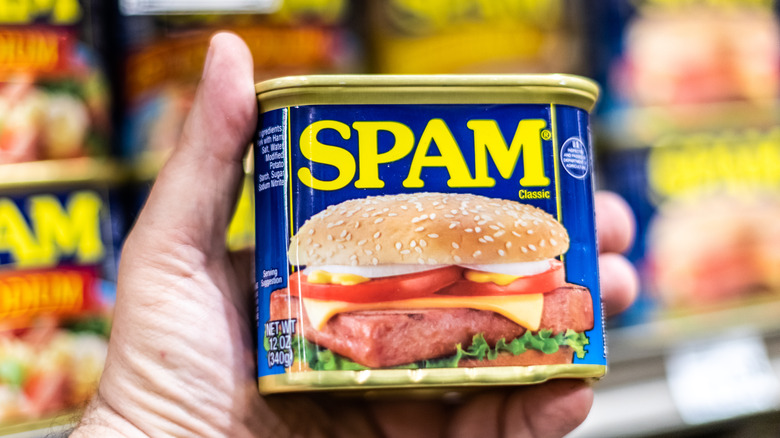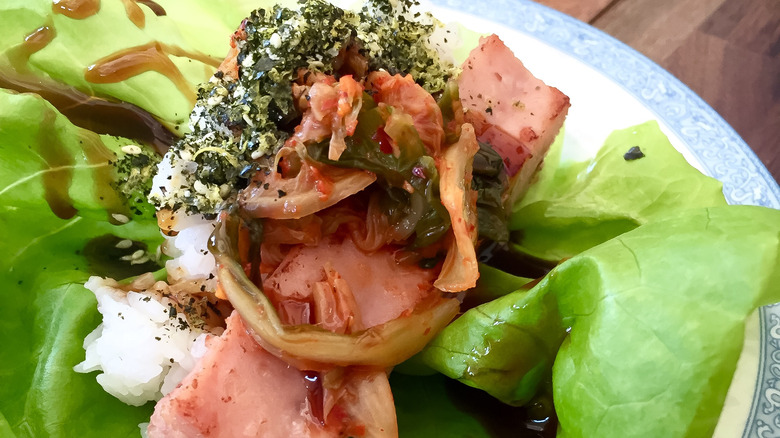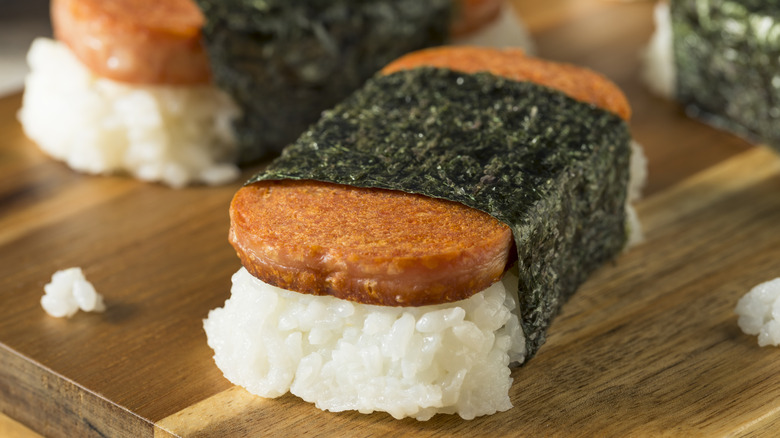9 False Facts About Spam Everyone Actually Believes
Oh, Spam. Beloved by many, misunderstood by ... a whole lot more. What started as a shelf-stable meat option that got many Americans through the end of the Depression, fed troops during World War II, and helped war-torn nations from across Europe to Russia to the Philippines and Korea stave off starvation has today not only been embraced by cuisines around the world but, in a time when food trends seem governed chiefly by the importance of all-natural, whole foods, has developed a cult following, appearing on the trendiest of menus across the country. The brand even tapped celebrity chef Roy Choi as the spokesperson for the bodega staple back in 2013.
But what is Spam, really? What's it made of? And how on earth did shelf-stable meat become so beloved? To answer these questions and more, we're debunking the most widespread myths about Spam, from naming conventions to perceptions surrounding it and more.
1. Spam's ingredients are shrouded in mystery
These days, a pervasive fear of processed food of all kinds seems to govern the foodie world. And we get it. Processed food ... isn't all that great for you, with studies showing the host of health risks linked to consuming a diet rich in ultra-processed foods, including but not limited to a higher risk of obesity, high blood pressure, cardiovascular disease, coronary heart disease, high cholesterol, and some forms of cancer. And processed meat specifically has been classed as a Group 1 carcinogen (aka known to cause cancer) by the World Health Organization.
That said, just because a food is processed doesn't mean it's mysterious: the contents of a can of Spam are in no way a secret. Spam's ingredients list, according to Hormel Foods, is actually relatively short, with just six items. Chief among them is pork, but contrary to what you might suspect, it's not scrap meat or castoffs. Indeed, LiveScience notes, the pork in Spam hails from the pork shoulder — a cut rich in fat and flavor. Its 1937 invention was spurred by a need to sell this portion, underused at the time.
To the pork shoulder are added five other ingredients: salt, water, potato starch (to bind everything together), sugar, and sodium nitrate (a preservative that keeps the ham fresh and, well, shelf-stable).
The ingredients are packed together and cooked in the cans, making Spam a ready-to-eat product that's quick, easy, and delicious. (And mystery meat free.)
2. There's just one flavor of Spam
With such a simple ingredients list of just six items, it doesn't seem like there's much room to toy with the flavor of Spam. But it turns out that "Classic" is just one of a whopping 15 different varieties that the brand has rolled out, ostensibly to "jazz up our Spam a little bit," Spam brand manager Nicole Behne told Eater.
Alternative options range from Spam flavored with anything from jalapeño to teriyaki sauce (the former, Behne tells Eater, sells particularly well in Texas; the latter quickly skyrocketed to popularity in Hawaii). There's Spam with Tabasco (dubbed "Hot & Spicy") and Spam with black pepper. There are even Spam alternatives for dietary concerns, like a Lite version and one with less sodium, and Spam products made with other meats, like real Hormel bacon or oven-roasted turkey. Spam also comes in convenient to-go packs.
3. Spam was invented for Army rations
While Spam was certainly a popular Army ration, it was not invented for this purpose. Indeed, the very first can of Spam was made in 1937 and therefore predates the onset of World War II by a few years. According to LiveScience, Spam was Jay Hormel's way of marketing the then-underused shoulder portion of hogs, and it was originally conceived, not for soldiers, but for busy housewives.
But just because it wasn't invented for this purpose doesn't mean that its popularity as an Army ration didn't contribute to its renown. Indeed, according to TIME, housewives were reticent to buy and prepare Spam at first, but during World War II, over 100 million cans were shipped to troops in the Pacific, where, thanks to its long shelf life, it became immensely popular among soldiers and locals alike. While it may not have been the motivation behind its invention, then, James Schend, the food editor at Taste of Home, tells Hormel Foods that World War II "cemented (Spam's) place in the culinary world."
4. Spam is super American
While Spam was indeed invented in the U.S. (specifically in Austin, Minnesota), it has become beloved all over the world, in part thanks to its omnipresence during World War II. Today, according to TIME, it (unsurprisingly) remains popular in areas where American soldiers were stationed, such as Guam and the Philippines. It was even enjoyed in Soviet Russia following the end of the War, where it was sent as part of aid packages.
"There were many jokes going around in the army, some of them off-color, about American Spam; it tasted good, nonetheless," wrote former Soviet Premier Nikita Khrushchev in his memoir "Khrushchev Remembers." "Without Spam, we wouldn't have been able to feed our army. We had lost our most fertile lands."
In South Korea, meanwhile, while Spam first arrived with troops during the Korean War, finding its way into fusion staples like budae jigae, literally, army base stew, today, the product has taken on a connotation of "glamour," according to the New York Times.
"Here, Spam is a classy gift you can give to people you care about during the holiday," Im So-ra, a saleswoman at Seoul's high-end Lotte Department Store, told the outlet. Today, South Korea is the largest consumer of Spam outside of the U.S., where, one local fan tells the Times, "it goes marvelously well with kimchi and rice."
5. Spam is no longer popular
Spam has a bit of an unfortunate reputation of being a food in times of scarcity, but don't let its rep confuse you: Spam remains incredibly popular. According to a LiveScience article from 2010, 90 million cans of Spam are sold in the U.S. every year; that's about three cans a second.
And Americans aren't the only ones enjoying the product! According to Marketplace, Spam is exported to 44 countries, and while it was perceived as a "war-time delicacy" by Margaret Thatcher, Bloomberg reports that the 2008 recession contributed to a marked rise in popularity for the humble canned ham product, with an 11% increase in sales from 2009 to 2011. Today, Adweek reports, Spam can be found in the pantries of a third of all American households, and 2021 marked a "record high" for sales of Spam in the United States. Hormel CEO Jim Snee told NBC News that demand for the canned meat was "as strong as it's ever been."
6. Spam is a lowbrow food
Spam may have a bit more of a highbrow reputation in South Korea, according to the New York Times, but what of its native land?
It turns out that despite its association with times of scarcity, Spam also has a nostalgic appeal for many, and as such, it has become an on-trend offering at "hip NYC restaurants" — or at least, that's what Gothamist reported back in 2014. The article highlighted creative uses of Spam throughout the Big Apple, including fried rice with seared ahi tuna, fresh pineapple, and Spam on New York Sushi Ko's $135 tasting menu or Spam musubi at trendy Suzume in hipster haven Williamsburg, Brooklyn.
To these dishes, Eater adds a foie gras loco moco, which could be found on the 2009 menu at Los Angeles' Animal. And when Celebrity chef Roy Choi even teamed up with the company he featured it in rice bowls and in stews at his LA restaurants Chego and POT, Eater reported. A Washinton Post article from 2019, reported that several fine dining restaurants in the DC area had embraced the canned meat on their menus as well.
7. Spam is made in Hawaii
Contrary to popular belief, Spam is not made in Hawaii ... but it's easy to understand the confusion. Hawaii is by far the biggest consumer of Spam in the U.S., thanks, according to TIME, to World War II military presence there. Today, Spam has become inextricable from the local Hawaiian cuisine, featuring, according to Eater, in such staple dishes as Spam musubi, a Hawaiian play on Japanese onigiri that features a slab of cooked Spam affixed to rice with nori, and an apparent favorite of President Barack Obama, National Geographic reports.
Spam also features in loco moco, where, according to Eater, it appears alongside rice, a burger patty, and a fried egg for a triple threat of protein. And it can be used, too, in fried rice, omelets, and more.
According to National Geographic, Hawaiians consume about 5 million pounds of Spam a year — about six cans per capita, and more than anyone else in the U.S. Hawaii even hosts a yearly festival in Waikiki — Spam Jam Hawaii — in honor of the beloved canned meat.
8. Using the word "spam" for junk mail is pure coincidence
It might be tempting to assume that Spam the canned meat and spam the junk email are coincidentally homophones, but the latter was actually derived from the former — much to the chagrin of Hormel.
It all started with a Monty Python skit from 1970. The skit shows two diners facing off with a Spam-focused menu, where the canned meat product was depicted an "inescapable annoyance," reported Gothamist. According to Digital Trends, this reference was embraced in the multi-user dungeon community beginning in the 80s, when people started using the term to describe the (equally annoying) practice of flooding databases or chats with data or useless text. This meaning found its way into the Oxford English Dictionary in 1998, and with the ever-increasing preponderance of junk mail, this denotation has only gained in strength.
Of course, at first, Hormel wasn't thrilled. The company notably sued companies like Spam Arrest, Spambuster, and Spamcube in the early aughts before finally embracing the term and even sponsoring the "Spamalot" musical in 2006.
"While the association of our product with the internet or e-mail 'spam,' including images, is in no way related," Rick Williamson, Manager of External Communications for Hormel Foods, told Digital Trends, "we strive to maintain a sense of humor around our iconic brand and enjoy consumers' fun-loving appreciation of it."
9. Its name is an acronym for scientifically processed animal matter
The question of the name of Spam was once plagued by retroactive etymology. Some would have you believe that Spam is an acronym for "scientifically processed animal matter," and while we suppose that's kind of an accurate description, Eater reports that it's pure urban legend. So, too, is the apt description of it as "Shoulder of Pork and Ham," but this feels pretty unwieldy and, the outlet notes, is also not the true origin of the word.
According to inventor Jay Hormel, Eater reports, Spam was a portmanteau of the words "spice" and "ham" and was coined by Kenneth Daigneau, an actor and the brother of a Hormel Vice President. Daigneau ostensibly came up with the name during a New Year's party (and pocketed $100 reward for finding the perfect name, according to Mental Floss). While Spam contains neither spice nor ham, the name stuck, and the rest is history.
